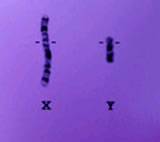Y chromosome sequence completedDNA readout reveals genetic palindromes
safeguard male-defining chromosome.
19 June 2003
JOHN
WHITFIELD
 |
| The Y chromosome has sex
with itself to guard against mutation. |
| ©
GettyImages | | |
Reports of the demise of the Y chromosome and an
impending extinction of men may have been exaggerated.
The Y's full genome sequence reveals that we have
underestimated its powers of self-preservation.
Instead of doubling up to protect its genetic cargo
like other chromosomes, the lone Y safeguards its genes
by having sex with itself, an international consortium
has found.
"We're on a quest to bring respectability to the Y
chromosome," says geneticist David Page of the
Massachusetts Institute of Technology, leader of the
sequencing team. The male-defining chromosome was
previously thought of as a wasteland where genes go to
die.
The Y's defences are double-edged, however, sometimes
leading to infertility. The sequence should help us to
diagnose and treat such genetic mishaps.
Two-way street
Human chromosome pairs swap genes to minimize bad
mutations. Y, which has no partner, faces being whittled
away by mutation. Some estimate that the chromosome
could be complete junk in about ten million years.
The finished sequence shows that the chromosome
fights entropy with palindromes. About six million of
its 50 million DNA letters reside in sequences that read
the same, in opposite directions, on both strands of the
double helix. The longest is nearly three million
letters long1.
"The Y chromosome is a hall of mirrors," says Page.
These palindromes house many genes - which means that
there is a copy at each end of the palindromic sequence.
These provide back-ups should harmful mutations arise.
The mirror-image structure also allows the arms to swap
position when DNA divides. Genes are shuffled and bad
copies are purged.
 |
| There are 50 million
letters in Y's finished sequence. |
| source:
Nature | | |
Page's team has calculated the amount of swapping
needed in each generation to produce the near-perfect
palindromes of the human Y. They estimate that every
man's Y contains 600 DNA letters that differ from his
father's2.
This is thousands of times more than the normal mutation
rate.
"No one had contemplated that there would be this
level of gene conversion in our own genome," says
Huntington Willard of Duke University, Durham, North
Carolina. "It gives us a glimpse of how the Y has
protected itself."
Other researchers see swapping as an evolutionary
accident, not a safeguard. "It's a daring suggestion,
but I find it a bit difficult to believe," says
geneticist Mark Jobling of the University of Leicester,
UK.
Jobling is sceptical because the trick has a high
cost: good genes are just as liable to be lost as bad.
This is a major cause of male infertility, as most of
the genes within the palindromes control testes
development. One in every few thousand men is infertile
because key genes have been deleted.
Y files
Genetic testing is already used to diagnose male
infertility. A fuller understanding of the Y's make-up
will help refine these tests, and improve doctors'
advice to couples. "We have a greater knowledge of where
the Y tends to break," says Page. "Testing needs to be
updated to reflect our better understanding from the
finished sequence."
The palindromes, and other forms of repeated DNA,
made the Y chromosome very tricky to sequence. So the
finished sequence comes from just one man's Y. Getting
more sequences is essential, says Jobling, as the
chromosome's structure, and hence biology, varies
greatly around the world.
"We have a beautiful snapshot of the Y chromosome,"
he says. "Now we need to look in other lineages to build
up a photo album of its diversity." | 

